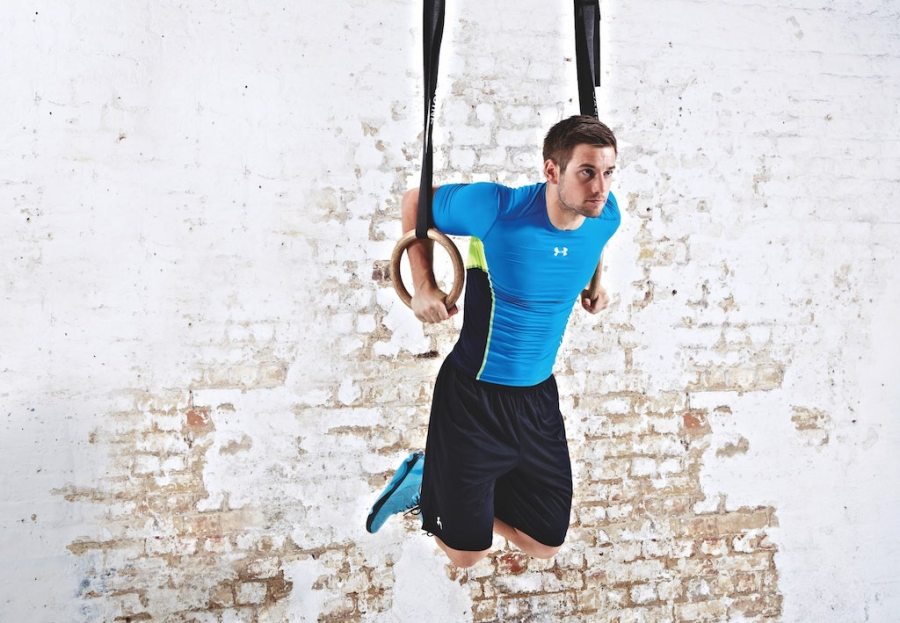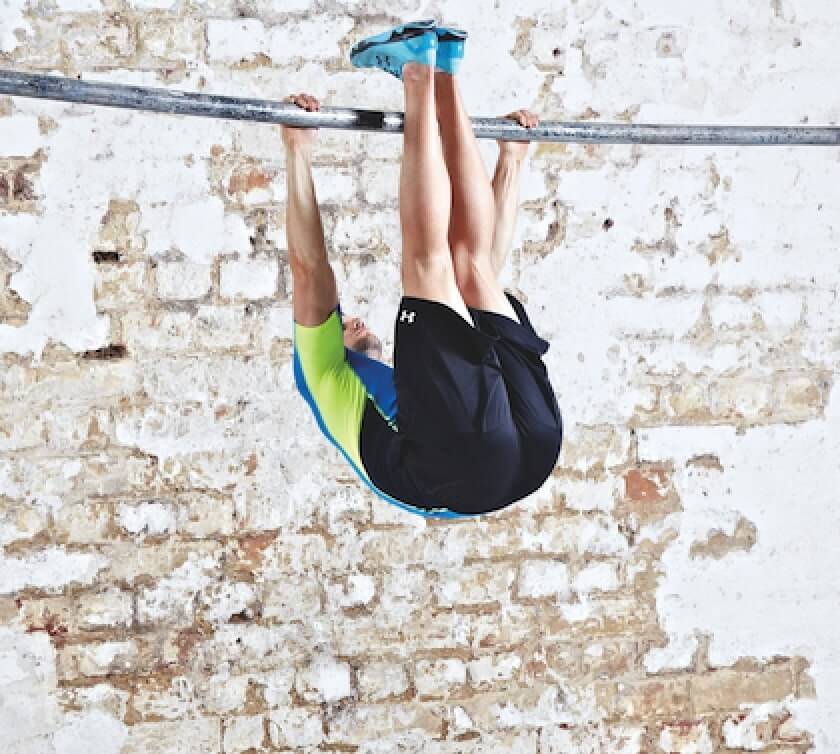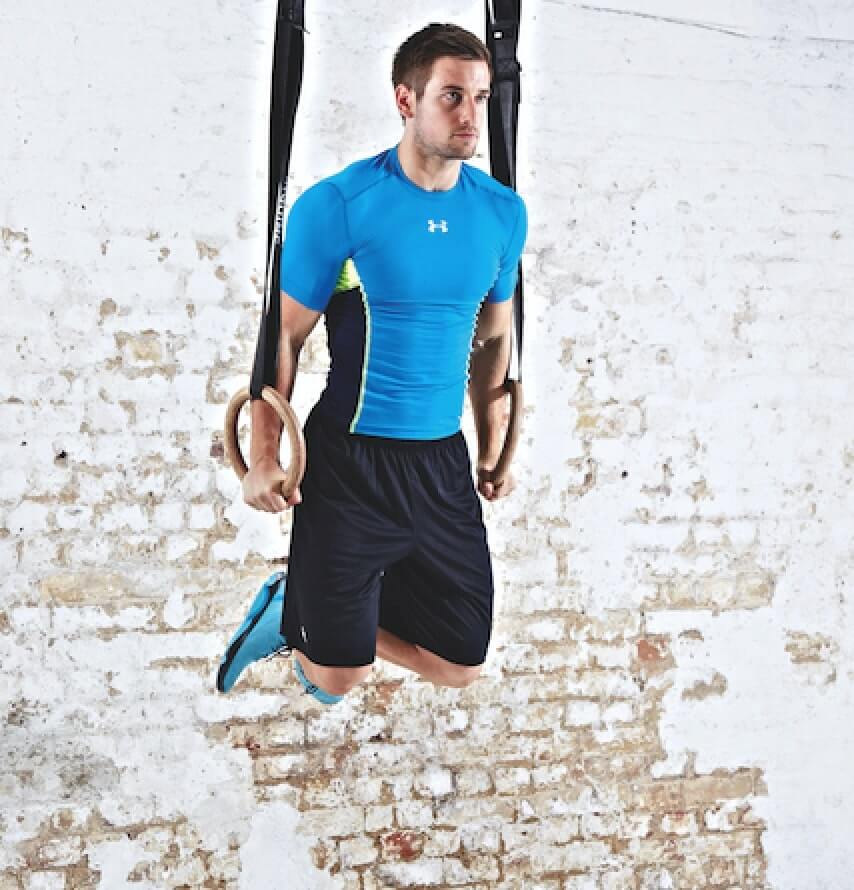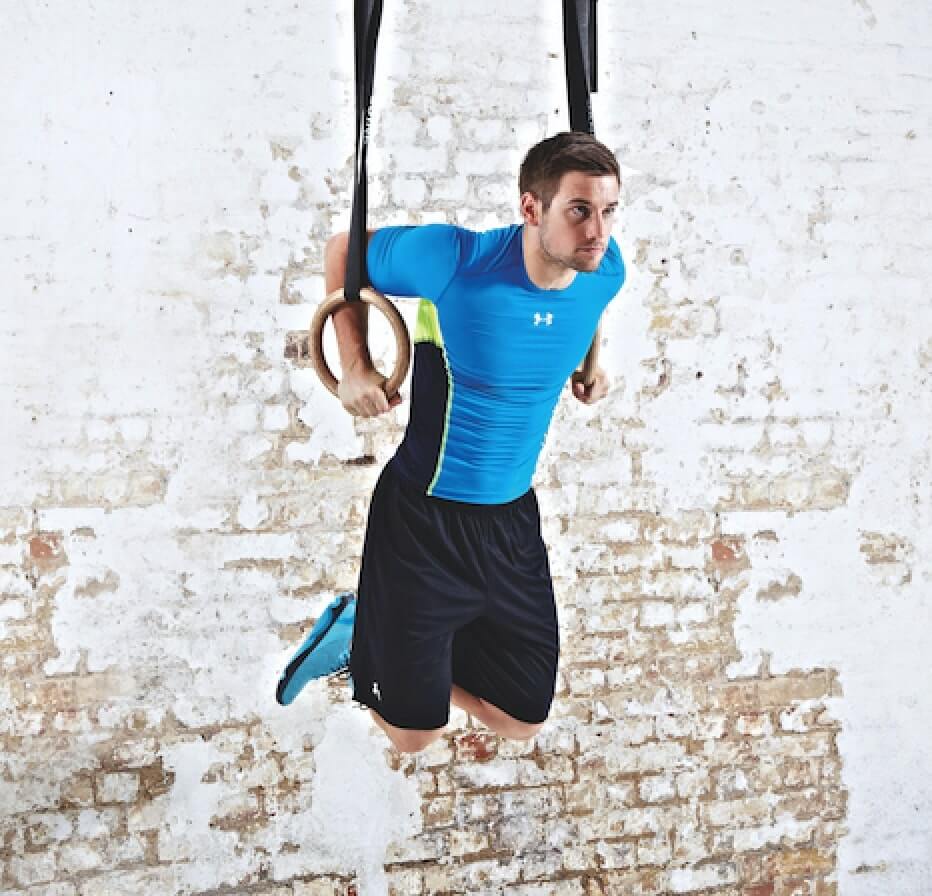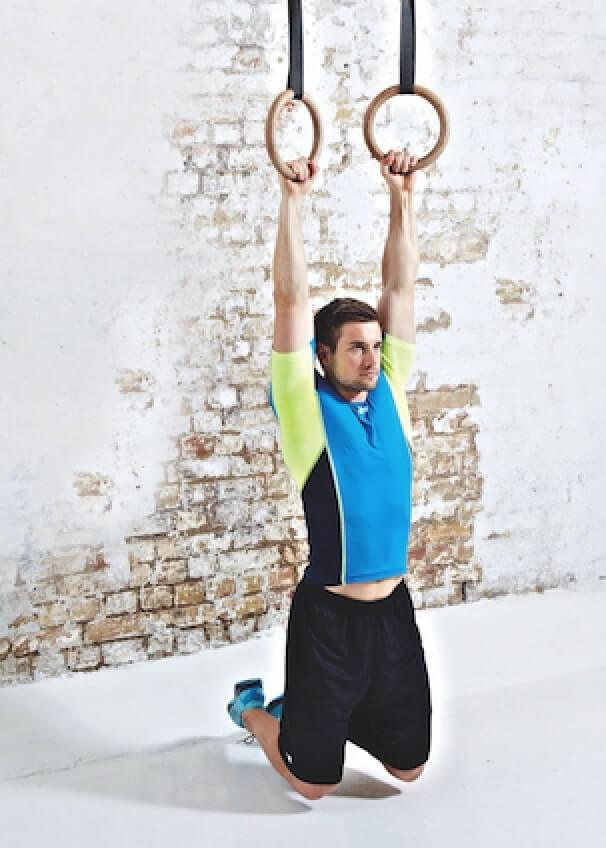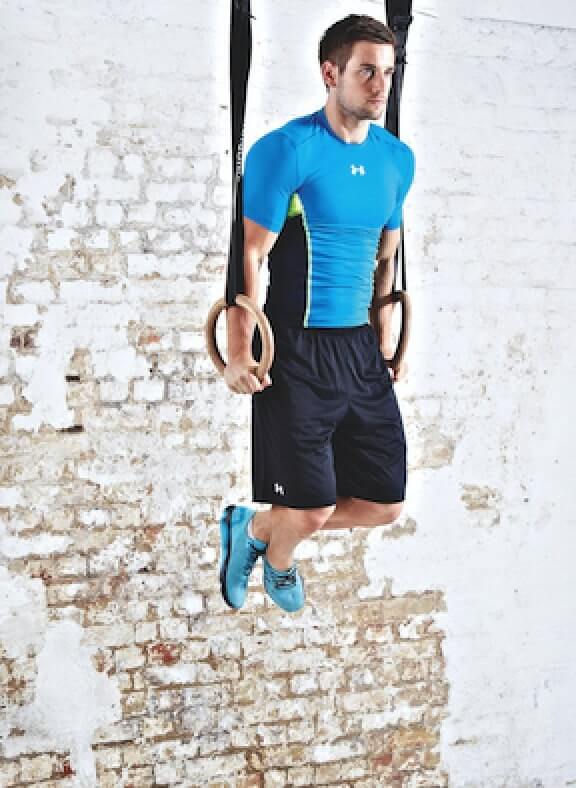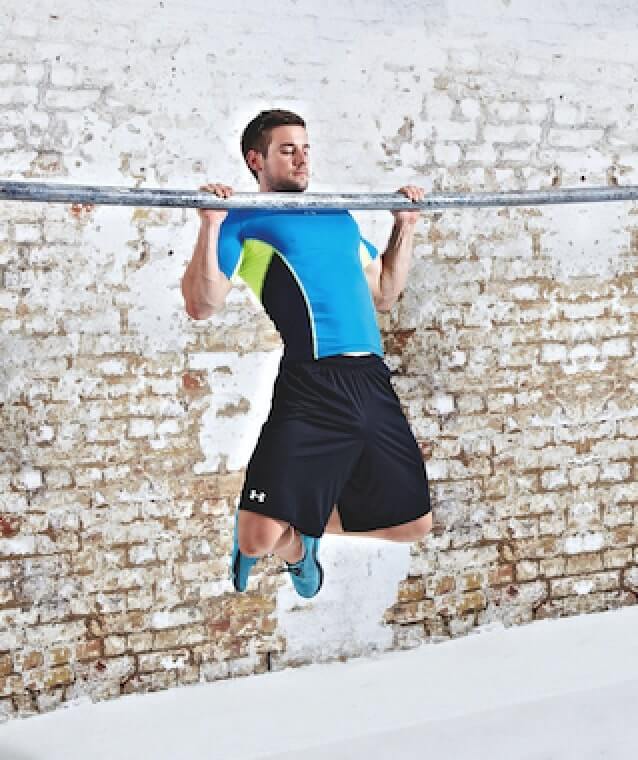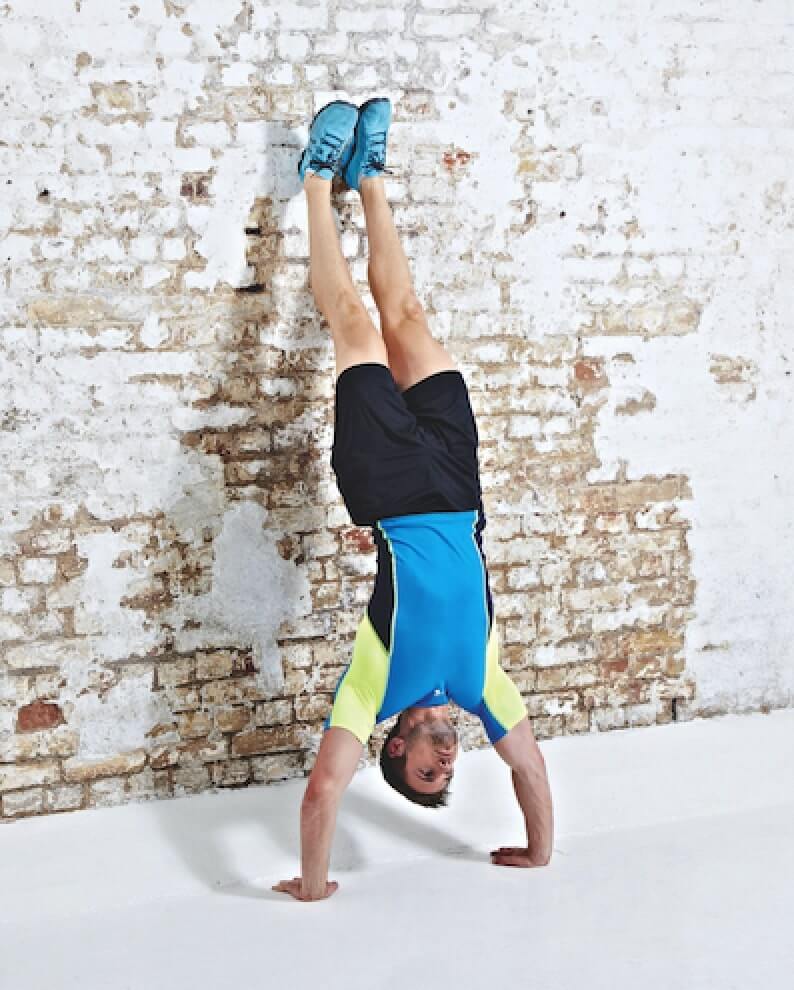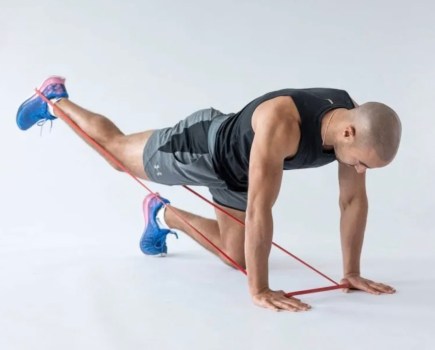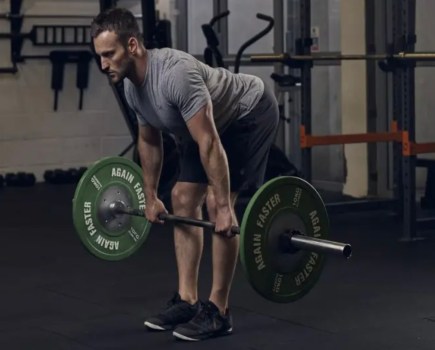David Jackson is a UK Strength & Conditioning Association accredited coach. With fellow S&C expert Tim Stevenson, he runs oneathlete.co.uk – a coaching outfit that combines their knowledge of S&C, calisthenics, physiotherapy and mental strength training.
Here you’ll learn all the gymnastics basics, with tips from Jackson to help speed the process along. Some of the moves are hard, but that’s the point. Bragging rights must be earned, after all.
1. Toes to Bar
WHY:
“Hanging exercises help to injury-proof your shoulders, because gripping a bar engages the shoulder stabilisers,” says Jackson. “Toes to bar can also help to build a solid six-pack as it places a lot of pressure on your lower abdominals.”
HOW:
- Hang from a bar with an overhand grip. Lean back slightly and draw your shoulder blades together while lifting your legs towards the bar.
- Straighten your legs to touch the bar with your toes.
- Lower back to a hanging position.
PRO TIP:
“Always lower with control to maximise the strength development of the core,” says Jackson. “To create adaptation we need tension, so being lazy and just letting your legs fall won’t help you to get the most from this exercise.”
2. Ring Dip
WHY:
“The dip is like a squat for your upper body, because it engages so many different muscles,” says Jackson. “Doing it on rings gives the stabiliser muscles in your shoulders an extra workout, which can help with some of your lifts.”
HOW:
- Adjust the rings so they’re just above hip height and grip them with your knuckles facing away from your body.
- Jump up and straighten your arms to support your weight, taking care to keep the rings close to your body.
- Lower yourself to below parallel or as low as your shoulders will allow. Pause briefly before extending powerfully to go back up to the start.
PRO TIP:
“Go as low as you can at first, but as your strength develops concentrate on increasing you range of motion,” says Jackson. “It will help massively if you want to move on to more advanced moves like human flags.”
3. Ring Muscle-Up
WHY:
“The muscle-up is the ultimate show-off bodyweight move for people in the know,” says Jackson. “It’s a combination of a pull-up and a dip, and you should be able to do 8-10 strict reps of both before even attempting it.”
HOW:
- Hang from a set of rings, palms facing in. The closer together the rings are, the easier you’ll find the move.
- Pull hard on the rings, keeping your elbows close to your sides. If you want to, you can add an explosive ‘kip’ at this stage, bringing your knees forwards and up to help with your momentum.
- At the peak of the pull, throw your head forwards as if you’re trying to headbutt someone. You should finish in the bottom of a very deep dip.
- Press it out to finish the move.
PROGRESSION MOVE:
“Ring muscle-ups are fiendishly hard at first,” says Jackson. ‘A strong pull is key. Do this progression exercise to help build the power needed to do a muscle-up in one fluid motion.”
- Dead hang from the rings. Explosively pull yourself up so the rings are in line with your shoulders, pulling back and down so your shoulder blades come towards each other.
- Hold the position for a couple of seconds, then slowly lower yourself to the start.
4. Bar Muscle-Up
WHY:
“A straight bar muscle-up removes the instability rings provide, but that doesn’t make it easier,” says Jackson. “In fact it’s harder, because you have to pull yourself up and around the bar to get above it.”
HOW:
- Jump up and grab the bar with an overhand grip around shoulder-width apart. Allow your body to swing forwards and backwards very gently.
- At the end of a forwards swing, just as you’re beginning to swing back, pull yourself up as aggressively as possible. The slight swing combined with the pull will give you the correct angle for going around the bar.
- Pull your chest towards the bar. At the peak of the pull-up, lean forwards and try to catch yourself in the bottom of a dip. Push up until your arms are fully extended.
- Reverse the actions to return to the start.
PRO TIP:
“Timing is crucial,” says Jackson. “Practise with your feet in a resistance band tied to the bar to take some of the load. This will help you train the mechanics and timing of the movement.”
5. Handstand Press-Up
WHY:
“This is a great way to develop shoulder strength and stability,” says Jackson. “And if you develop the balance to do it without a wall, you’ll look like an absolute boss.”
HOW:
- Place your hands about 30cm from a wall and kick your legs over your head and rest them against it.
- If you’re struggling, lead with one leg and progressively kick harder until you feel the wall, then bring your other foot up to meet it.
- Brace your core and lower your head towards the floor. Take a progressive approach with this and only go as far as you feel you can control. As you get stronger, you’ll be able to move your head closer to the ground.
- At the bottom of the press-up, tense your core again and push down hard, straightening your elbows until you’ve returned to the start.
PRO TIP:
“Once you feel confident, try to rest as little weight as possible on the wall through your legs,” says Jackson. “It’s too easy to think you’re doing a decent rep when really you’re just cheating your way through it.”
6. Handstand Walk
WHY:
“This is a good move for developing strength and stability in your shoulders, while enhancing the coordination of your shoulder joints with the rest of your body,” says Jackson. “It’s also useful if your legs ever get too tired to walk!”
HOW:
- Place both hands on the ground with your index fingers facing forwards. Spread your fingers to give you a wider base.
- Kick up powerfully with one leg and allow the other to follow, aligning your wrists, elbows and shoulders. Practise on a soft, stable surface first so you can roll out of the handstand safely if necessary.
- Let your knees bend a little to take more weight past your head and tip you in the direction you want to go.
- Walk with your hands using small, light ‘steps’.
PRO TIP:
“Dangling your legs forwards is the equivalent of an accelerator,” says Jackson. “Have a friend on standby to catch and reset your legs if you get overeager.”
Words: Max Anderton and Matt Huckle / Photography: Ben Knight / Model: Alex Crockford

